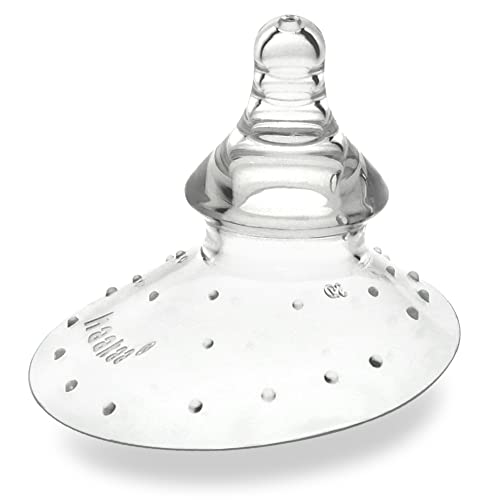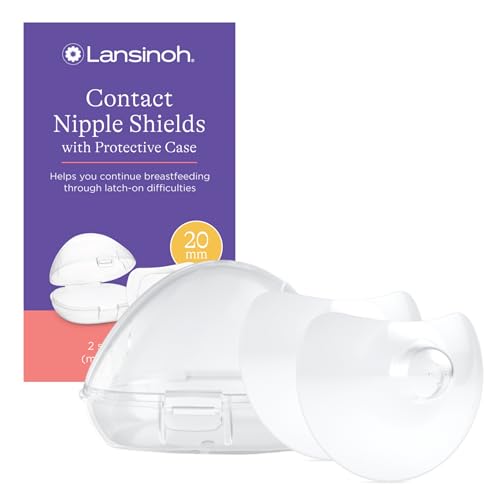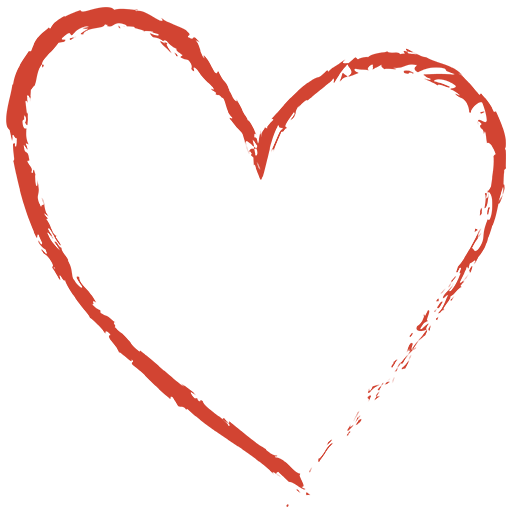As a new mother, breastfeeding can be a beautiful bonding experience, but it can also come with its own set of challenges. From latch-on issues to inverted or flat nipples, these difficulties can lead to discomfort and pain for the mother, as well as potential issues with the baby receiving the nutrition they need.
That’s where nipple shields come in. In this guide, we’ll be discussing the benefits of using nipple shields, how to choose the right size and type, and how to properly use and care for them. We’ll also be sharing some tips and tricks to make breastfeeding with nipple shields a more comfortable and successful experience for both mother and baby. Additionally, be sure to check our list of the best nipple creams for breastfeeding as well.
Our Top Picks
- Best Nipple Shield For Sensitive Nipples: Philips AVENT Nipple Shield
- Best Nipple Shield For Latching Issues: Cradle Plus Nipple Shield
- Best Nipple Shield For Flat Or Inverted Nipples: haakaa Nipple Shield
- Best Nipple Shield For Small Nipples: Medela Contact Nipple Shield
- Best Nipple Shield For Large Nipples: Ameda Contact Nipple Shields
- Best Nipple Shield For Tounge Ties: Lansinoh Nipple Shield
- Best Nipple Shield For Newborns: MAM Breastfeeding Nipple Shields
- Best Nipple Shield For Transitioning From Bottle To Breast: purifyou Nipple Shields
In This Article
HappyBabyHub’s Best Nipple Shields For Breastfeeding Picks
Philips AVENT Nipple Shield – Best Nipple Shield For Sensitive Nipples
- 2 different cup attachments
- The silicone that lays on the breast is comfortable
- Protects nipples from friction against your bra
- Ventilation of air into nipples
- Outward appearance through clothing varies greatly depending on breast size and the type of bra used
These shields are made of soft, odorless, and tasteless silicone that provides much-needed comfort and support during breastfeeding.
By covering the nipple, these protectors allow you to breastfeed for longer periods without any discomfort. The shields have holes in them that enable your baby to latch on and suckle milk easily. Not only that but the shields are also designed to be small enough so that your baby’s nose and chin can touch your skin, ensuring maximum skin contact during feeding.
The thin and flexible silicone of the nipple shields conforms to your nipple, providing an easy latch-on for the baby. Plus, these shields come with a handy storage case and two medium-sized shields.
Cradle Plus Nipple Shield – Best Nipple Shield For Latching Issues
- The cups catch all the milk
- Great latching
- Very easy to work with
- Comes with a storage case
- The nipple shield is small so if you have a large nipple, this won’t work
This kit includes two ultra-soft and flexible contact nursing shields, two Breast Shells milk savers made of food-grade silicone and PVC, and a portable storage or carrying case. These shields are particularly great if you experiencing latching issues.
They provide a discreet and comfortable way to breastfeed in any setting, while the milk savers are designed to blend seamlessly into your bra, making them comfortable and unobtrusive.
They are made of high-quality silicone that conforms perfectly to your nipple, allowing for easy latch-on while promoting skin-to-skin contact with your baby.
Plus, they also feature an integrated spout for air circulation that can be used to dispense milk into bottles, and the four openings on the nipples aid in regular milk flow while also preventing milk from collecting during an excessive let-down.
haakaa Nipple Shield – Best Nipple Shield For Flat Or Inverted Nipples
- Does help mimic the nipple to the bottle
- It’s very easy to use
- It’s easy to wash and sterilize
- Has a strong suction when applied correctly, and is comfortable
- You have to sit up forward so milk can come out your nipple basically like gravity
The Haakaa Nipple Shield is an ingenious solution for nursing mothers who struggle with flat, inverted, or sore nipples. Its patented design features a unique nipple head that mimics the natural sucking rhythm of a baby, making it easier for your little one to latch on and nurse effectively.
Crafted from high-grade silicone, the Haakaa Nipple Shield is incredibly soft, pliable, and lightweight, ensuring a comfortable fit for both mom and baby. But the real magic is in its spiral mechanics, which prevent milk from submerging during feeding and reduce the risk of flatulence and choking.
With its cross-milk hole and adjustable nipple design, the Haakaa Nipple Shield ensures that milk flows safely and comfortably into your baby’s mouth. Plus, the shield’s space between the mother’s nipple and the baby’s mouth helps to prevent little ones from accidentally chewing on the shield.
Medela Contact Nipple Shield – Best Nipple Shield For Small Nipples
- Makes breastfeeding more enjoyable
- Helps with a powerful letdown
- Easy to clean
- Transfers the milk well
- Can fall off your boob
This nipple shield is made from 100% ultra-thin and soft silicone, which conforms snugly to your nipple and provides a comfortable fit, which is especially important if you have small nipples. It has a unique design that features a cut-out region that maximizes skin contact between the mother and baby, making it easier for the baby to latch on and nurse comfortably.
The Medela Contact Nipple Shield set comes with two shields. Plus, it includes a lightweight carrying case for easy travel and storage.
Ameda Contact Nipple Shields – Best Nipple Shield For Large Nipples
- Similar to what a hospital gives
- Stays in place
- Soft and flexible
- Comfortable
- These are thin
Made from soft and flexible silicone, these shields are gentle on mom and baby’s delicate skin, and they can be reused after washing.
What’s amazing about Ameda Nipple Shields is that they can reduce friction during breastfeeding. If you’re experiencing discomfort or pain due to a poor latch, these shields can act as a barrier between your baby’s gums and your nipples. This can help protect your nipples and speed up the healing process.
And don’t worry about harmful chemicals – Ameda Nipple Shields are BPA- and DEHP-free, making them safe for both you and your baby. Plus, the shields are designed to allow your baby’s nose and chin to touch your breast, which promotes important skin-to-skin contact during feeding. And if you have larger nipples, these shields are a great option for you too!
Lansinoh Nipple Shield – Best Nipple Shield For Tounge Ties
- Great for sore nipples
- Very thick
- Minimally intrusive during feeding
- Very easy to clean, either with soap and water or boiling
- Limited sizes available
These nipple shields are specifically designed to help you overcome common breastfeeding challenges like flat or inverted nipples and provide a comfortable and effective solution. And they’re great for little ones with tongue ties, too!
The nipple shields are made from BPS and BPA-free silicone, which means that they’re safe for both mom and baby to use. Plus, they’re ultra-thin, soft, and flexible, so they’re gentle and comfortable for both of you. And the unique cut-out design promotes maximum skin-to-skin contact between you and your baby, so you can continue to bond and breastfeed without interruption.
When you’re not using the nipple shields, simply store them in the convenient carrying bag that comes with them.
MAM Breastfeeding Nipple Shields – Best Nipple Shield For Newborns
- Easy transition for baby
- Baby latches well and gives enough stimulation not to hurt
- Stays put
- Helps get milk easily
- Pretty large surface area
These shields are specifically designed to fit the unique shape and size of your nipples, with size 2 intended for nipples with a maximum diameter of 23mm.
One of the standout features of MAM nipple shields is their thin, natural SkinSoft silicone surface. This material is carefully crafted to fit your breast, promoting maximum skin-to-skin contact between you and your baby. This contact helps with bonding, attachment, and regulating your baby’s temperature and heart rate.
What’s more, MAM nipple shields have a rough surface that allows air to circulate freely between your child and the shield. This is especially important for your baby’s delicate skin, as it prevents irritation and discomfort. Additionally, this rough surface ensures that the shield stays in place during breastfeeding, providing a secure grip for your child.
purifyou Nipple Shields – Best Nipple Shield For Transitioning From Bottle To Breast
- Great price
- Easy to clean
- Stimulate nipples because it’s silicone and attached right to your skin
- They are breathable
- Falls of easily
These nipple shields are a great choice for transitioning your baby from bottle to breast and they come in two sizes, 20mm (0.78in) and 24mm (0.94in) diameter, ensuring a perfect fit for your nipples. The shields are super easy to apply and have been specifically designed to provide the best attachment possible, all while allowing for skin-to-skin contact with your little one.
One of the standout features of these nipple shields is their length and unique shape. They can help with any latch-on issues or even flat or inverted nipples, making breastfeeding more comfortable and enjoyable for both mother and child.
Plus, these shields are made from non-toxic, BPA-free, BPS-free, latex-free, phthalates-free, and lead-free materials, providing moms with peace of mind that they’re using a safe and healthy product. And as a bonus, they even come with a free cotton bag for easy storage!
You Might Also Like: Best Nursing Pajamas
How To Choose The Best Nipple Shields for Breastfeeding?
- Size: If your nipple shield is too small, your nipple won’t have enough room to expand while your baby is suckling, which can be painful. If the nipple shield is too large, it can be frustrating for both you and your baby, as it might not stay in place while you are nursing. To establish the size of your nipple shield, the diameter of your nipple at the base should be measured in millimeters (not including the areola) (1).
- Material: If you have sensitive skin or a silicone allergy, you may want to look for a nipple shield that is not made of silicone. There are several advantages to using silicone if you have no problems with it. A nipple shield made of silicone fits precisely and is comfortable to wear because it is flexible and water-resistant. It is also more environmentally friendly than a substance like plastic.
- Shape: When choosing a nipple shield, look for one with cutaway sections. This will provide a more realistic feel and eliminate the need for a nipple shield material. Cutaway sections also make it more comfortable for both you and your baby to lay their nose and chin on your breast flesh. However, the shield is more likely to move about when in use the less surface area it covers, which can be annoying.
- Easy To Clean: Some shields are dishwasher safe, while others need to be cleaned by hand. Choose a shield that is easy to clean so that you can keep your baby healthy and safe.
What Is A Nipple Shield?
A nipple shield is a small, flexible silicone cup that covers the nipple and areola during breastfeeding (2). Nipple shields can help protect the nipple from cracking and soreness, and can also help the baby latch on correctly.
How Do I Know My Nipple Shield Size?
To find the right nipple shield size, it’s important to start with the nipple diameter. Measure your nipple’s base diameter across the center in millimeters using a ruler not including the areola. The nipple should fit snugly into the nipple shield, without bulging out the sides. If the nipple does bulge out, it’s likely that the shield is too small.
How To Use A Nipple Shield?
A nipple shield can be a useful tool for nursing mothers. Here are some tips on how to use one:
- Firstly, make sure the shield is the right size. It should fit snugly over your nipple, but not be so tight that it causes pain.
- To put the shield on, hold it in place with your thumb and forefinger. Then, gently pull your nipple into the center of the shield.
- When you are ready to nurse, put the shield in place and then latch your baby on. You may need to experiment a bit to find the best way to position the shield and your baby.
- Once your baby is latched on, you can remove the shield. To do this, gently slide it off of your nipple.
Are Nipple Shields Good For Breastfeeding?
Nipple shields are a tool that can be used to help mothers who are struggling to breastfeed. They can provide relief for sore or cracked nipples, and can help the baby to latch on correctly. Nipple shields can be a valuable tool for breastfeeding mothers, but it is important to talk to a lactation specialist before using one.
When Should I Use A Nipple Shield?
It is recommended to use a nipple shield if you have a particularly flat or inverted nipple, which can make it difficult for your baby to latch on (3). Also if you have a premature newborn or your baby has tongue ties. Some mothers also find that using a nipple shield can help with pain relief, as it can protect your nipples from the baby’s sucking.
Do Nipple Shields Cause Low Milk Supply?
There have been some instances where mothers who use nipple shields have reported that their milk supply has decreased. It is possible that the nipple shields are interfering with the baby’s ability to latch on properly, which could lead to less milk being consumed (4). And some research supports this (5). If you are using nipple shields and notice that your milk supply is decreasing, you may want to speak to a lactation consultant to see if there is another solution.
Do Nipple Shields Cause More Gas?
It is possible that using nipple shields can cause more gas in babies. This is because the shields can block the baby’s nose, making it harder for them to breathe and causing them to swallow more air. If you are using nipple shields and your baby seems to be gassy, you may want to try using a different type of shield or giving them gas relief drops.
What Is The Difference Between A Nipple Shield And A Breast Shell?
A nipple shield is a thin, lightweight piece of silicone that covers the nipple and areola. It is most commonly used to protect the nipple during breastfeeding, to help the baby latch on, or to relieve nipple pain.
A breast shell is a larger, heavier piece of equipment that is placed over the entire breast. It is typically used to help relieve engorgement, blocked ducts, or mastitis.
Do I Need To Pump After Nursing With Nipple Shield?
If you are using a nipple shield while nursing, you will likely need to pump afterward in order to remove all the milk from your breast. If you’re using a nipple shield, it’s important to make sure that your baby is getting enough milk. You can check this by looking for signs that your baby is feeding well, such as weight gain, wet diapers, and dirty diapers.
Do Nipple Shields Help With Shallow Latch?
Nipple shields are often used to help with a shallow latch. A shallow latch can make it difficult for a baby to get enough milk, and a nipple shield can help to increase the amount of milk that a baby gets with each feeding. Nipple shields can also help to prevent pain for the mother while breastfeeding.








